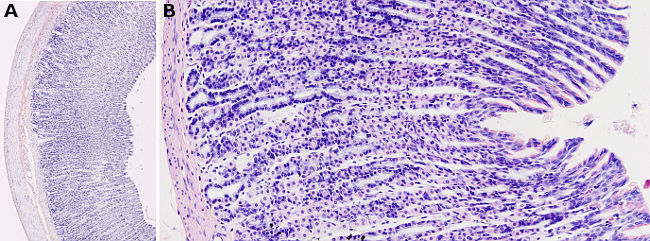Animal organs. Digestive.
STOMACH

Species: rat (Rattus norvegicus; mammal).
Technique: paraffin embedding, stained with haematoxylin-eosin
The stomach is the cavity of the digestive system where food is hydrolyzed by the gastric juice. It shows a J-like shape and is more flattened in the anterior-posterior axis. Stomach is located between the esophagus and the small intestine. The gastro-esophageal sphincter, found in the transitional zone between the esophagus and the stomach, prevents gastroesophageal reflux (food turning back from the stomach back to the esophagus). There are major differences in the histology of the digestive tube between the esophagus and the stomach.
Food enters the stomach after being masticated and moistened by saliva in the mouth. Food remains several hours in the stomach while is moved and degraded by stomach juice containing hydrochloric acid, enzymes and mucus. Stomach epithelial cells release the components of the stomach fluid, including enzymes like pepsin for degrading proteins and lipases for hydrolyzing lipids. Molecules like the hormone gastrin, that promotes the absorption of vitamins, are also released.
The stomach is divided in four parts: cardia, fundus, body and pyloric antrum. The cardia is the region where the esophagus joins the stomach. The fundus shows a dome-like shape that rises higher than the cardia. The body is the largest region of the stomach. The pyloric antrum is the smallest region that forms a funnel-like structure that joins to the small intestine through the pylorus. In this area, the pyloric sphincter controls the passing of the gastric content to the duodenum, the first segment of the small intestine.
Like other parts of the digestive tube, the stomach consists of four layers: mucosa, submucosa, muscularis and serous.
Mucosa is formed of a simple epithelium with columnar cells arranged in highly and compact foldings. The deep parts of these folds form the gastric glands, that are simple tubular or branched tubular glands. The secretory epithelium of the deeper part of gastric glands releases mucous compounds that cover and protect the luminal surface of the stomach. Three regions are found in the stomach regarding the histological organization of the mucosa: cardiac region, fundic (fundus and body) region, and pyloric (pylorus and antrum) region.
In the cardiac region, the transition from the stratified squamous epithelium of the esophagus to columnar epithelium of the stomach occurs. The stomach eptihelium folds to form the first stomach glands, not too large in this region, and with tubulo-alveolar morphology. Most of their secretory cells are mucous with a few enteroendocrine cells that release gastrin, hormone involved in the stomach movements and in the activity of secretory cells.
The fundic region, which includes the fundus and the body, is characterized by having moderately deep gastric pits (folds of the epithelium), with up to seven gastric glands ending in their deeper parts. Glands are tubular, straight and long, sometimes the deeper parts reach near the muscularis mucosae. The upper part of the gland is known as neck or isthmus. In this part of the stomach, gland epithelium contains five types of cells, which also appear in other regions of the stomach.
Mucous cells, located in the neck of the gastric glands, release liquid sulfated mucus. This secretion is different from the mucus released by mucous cells located in the gastric pits. Mucous cells are abundant in the neck of the fundic glands.
Stem cells are found in the upper part of the neck of the gastric glands. They are in charge of the of renewing of the superficial epithelium, as well as the other cell types of the gland epithelium.
Parietal cells, or oxyntinc, release hydrochloric acid. They are larger cells with a wide eosinophilic cytoplasm, triangular-like in shape, and they may have two nuclei. They are mostly found in the neck, but also in deeper parts of the glands.
Chief cells are the smaller cells of the gastric glands. They show basophilic cytoplasm due to the high amount of pepsinogen, inactive precursor of pepsin, which is the released product. The release of pepsin is induced by gastrin, histamine and acetylcholine, but inhibited by somatostatin. In the fundic region, chief cells are mostly located in the deeper part of the gland.
Endocrine cells are distributed all over the gastric mucosa. They can be distinguished morphologically and release several hormones and neurotransmiters.
The pyloric region is the last part of the stomach, 5 cm long in humans. It has deep gastric pits and branched and rolled tubular gastric glands. Glandular cells mostly mucous cells, although there are gastrin and pepsin releasing cells as well.
The stomach epithelium rests over the basal lamina, which is a very thin layer of specialized extracellular matrix. Lamina propria is found under the basal lamina. Lamina propria is a thin layer of loose connective tissue with abundant diffuse lymphoid tissue, and contains collagen and reticular fibers. Muscularis mucosae is located under the lamina propria, with two layers of muscle cells, one arranged circularly, (perpendicular to the major axis of the stomach) and the other longitudinally (parallel to the major axis of the stomach). A third layer, with oblique oriented cells, is sometimes observed.
Submucosa is connective tissue with many lymphocytes and plasma cells. Abundant blood and lymphatic vessels are also present in this layer.
Muscularis propria is found under the mucosa. It consists of three layers of smooth muscle: inner oblique, middle circular and outer longitudinal. Between the circular and longitudinal layers, there are nerve fibers forming the Auerbach's plexus, which coordinates the contractions of the stomach during digestion.
The serosa layer of the stomach is similar to that found in other parts of the digestive tube. It is continued with the visceral and abdominal cavity walls.
